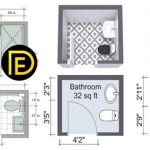How to Vent a Bathroom Exhaust Fan Through the Roof: A Comprehensive Guide
Proper ventilation in a bathroom is crucial for maintaining air quality, preventing moisture buildup, and eliminating odors. An exhaust fan is an effective solution for ventilating the space, and installing it through the roof is often the preferred method for maximum efficiency and aesthetics.
Venting an exhaust fan through the roof involves several essential steps that require careful attention to ensure proper functionality and safety:
Determining the Fan's Capacity
Before starting the installation, it's essential to determine the required fan capacity for the bathroom. The fan's capacity, measured in cubic feet per minute (CFM), should match the size of the bathroom and the desired ventilation rate.
Selecting the Right Ducting
Selecting the correct type and size of ducting is crucial for efficient ventilation. Typically, rigid or flexible metal ducting is used for bathroom exhaust fans. The diameter of the duct should match the fan's outlet size, and the duct should be as short and straight as possible to minimize resistance to airflow.
Choosing the Roof Exit Point
The roof exit point should be carefully selected to avoid potential obstructions, such as chimneys or existing vents. It's also important to ensure that the exit point is far enough away from windows and doors to prevent moisture from re-entering the bathroom.
Preparing the Roof
Before installing the exhaust duct, the roof must be prepared by cutting a hole for the duct to pass through. The hole should be cut to the exact size of the duct and sealed with flashing to prevent water leakage.
Installing the Duct
The duct is typically connected to the fan's outlet using a duct clamp. The duct is then guided through the roof hole and secured with roof sealant. It's important to ensure that the duct is properly sloped to prevent condensation accumulation.
Installing the Roof Cap
A roof cap is installed over the roof exit point to protect the duct from the elements and prevent moisture from entering the roof. The roof cap should be compatible with the duct size and should be properly sealed with caulk or flashing.
Electrical Wiring
The exhaust fan requires electrical wiring to operate. The wiring should be connected to the fan's motor and extended through the roof hole. It's essential to follow electrical codes and ensure the wiring is properly secured.
Testing the System
Once the installation is complete, the exhaust fan should be tested to ensure proper operation. Turn on the fan and check for adequate airflow. Look for any signs of leaks or improper sealing, and address any issues promptly.
By following these steps and paying attention to the essential aspects of roof venting, you can ensure that your bathroom exhaust fan is properly installed and effectively ventilates the space, improving air quality, preventing moisture buildup, and eliminating odors.

Installing A Bathroom Fan Fine Homebuilding

Bathroom Exhaust Fans Building America Solution Center

Blog

Venting A Bath Fan In Cold Climate Fine Homebuilding

How To Replace And Install A Bathroom Exhaust Fan From Start Finish For Beginners Easy Diy

Venting A Bathroom Through Sips Fine Homebuilding

Bathroom Vent Piping To Near Exterior Inspecting Hvac Systems Internachi Forum

Bathroom Fan Venting Tips Gui

Roof Flashing For Bathroom Fans

I Am Stuck On A Bathroom Exhaust Vent Installation Doityourself Com Community Forums







